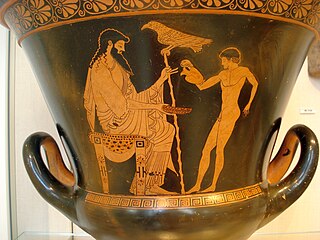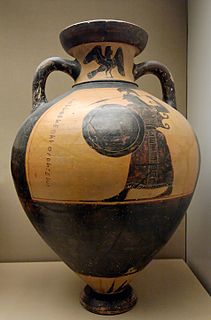Kleitias was an ancient Athenian vase painter of the black figure style who flourished c. 570–560 BCE. Kleitias' most celebrated work today is the François Vase, which bears over two hundred figures in its six friezes. Painted inscriptions on four pots and one ceramic stand name Kleitias as their painter and Ergotimos as their potter, showing the craftsmen's close collaboration. A variety of other fragments have been attributed to him on a stylistic basis.

The Kerch style, also referred to as Kerch vases, is an archaeological term describing vases from the final phase of Attic red-figure pottery production. Their exact chronology remains problematic, but they are generally assumed to have been produced roughly between 375 and 330/20 BC. The style is characterized by slender mannered figures and a polychromatism given to it by the use of white paint and gilding.

The Andokides Painter was an ancient Athenian vase painter, active from approximately 530 to 515 B.C. His work is unsigned and his true name unknown. He was identified as a unique artistic personality through stylistic traits found in common among several paintings. This corpus was then attributed by John D. Beazley to the Andokides Painter, a name derived from the potter Andokides, whose signature appears on several of the vases bearing the painter's work. He is often credited with being the originator of the red-figure vase painting technique. To be sure, he is certainly one of the earliest painters to work in the style. In total, fourteen amphorae and two cups are attributed to his hand. Six of the amphorae are "bilingual", meaning they display both red-figure and black-figure scenes.

The Pan Painter was an ancient Greek vase-painter of the Attic red-figure style, probably active c. 480 to 450 BCE. John Beazley attributed over 150 vases to his hand in 1912:
"Cunning composition; rapid motion; quick deft draughtsmanship; strong and peculiar stylisation; a deliberate archaism, retaining old forms, but refining, refreshing, and galvanizing them; nothing noble or majestic, but grace, humour, vivacity, originality, and dramatic force: these are the qualities which mark the Boston krater, and which characterize the anonymous artist who, for the sake of convenience, may be called the 'master of the Boston Pan-vase', or, more briefly, 'the Pan-master'."

Eucharides Painter is the common nickname of an ancient Greek artist who decorated but did not sign attic vases. Neither his real name, nor the dates of his birth and death are known. Presumably this artist was a pupil of the Nikoxenos painter.

The Piraeus Painter was one of the first Attic black figure vase painters. He was active between 630 and 600 BC.

The KX Painter was an Attic black-figure vase painter. He was active between 585 and 570 BC.

The KY Painter was an Attic black-figure vase painter. He was active between 585 and 570 BC.
The Panther Painter was a vase painter of the Attic black-figure style. He was probably active at the same time as the Nessos Painter, or shortly thereafter. Both shared a predilection for interlace patterns. The Panther Painter's vases have so far only been found in Attica, but outside Athens, at Vari. It is therefore assumed that he did not live and work in Athens, but only produced for a small local market in Attica. He mainly painted lekanis with animal friezes.

The Anagyros Painter or Anagyrus Painter was a vase painter of the early Attic black-figure style, active in the first quarter of the 6th century BC. His works have only been found in inland Attica, mainly at Vari, but not in Athens itself. It is thus assumed that he was not active within the city and only produced for a very limited rural area. In contrast to many of his contemporaries, he did not paint lekanes but various large formats, such as amphorae, kantharoi, chalices, oinochoai and plates.
The Painter of the Dresden Lekanis is the common name for a vase painter of the Attic black-figure style, active around 580-570 BC. He emigrated to Boeotia and is in fact identical with the Boeotian Horse-bird Painter.

Burgon Group is the conventional name given to a group of Attic black-figure vase painters active in the middle third of the sixth century BC.
The Goltyr Painter was an Attic vase painter of the black-figure style. He was active in the second quarter of the sixth century BC. He is well known for his work on Tyrrhenian amphorae. He mostly painted animals, often with rather bulbous heads.

The Little masters were a group of potters and vase painters who produced vases of the Attic black-figure style featuring well-done figures in miniature. They were active in Athens approximately 560 — 530 BC. They mainly produced Little-master cups: lip cups, band cups and droop cups, but were not entirely limited to such shapes. The group includes:

The Leagros Group was a group of Attic black-figure vase painters active during the last two decades of the 6th century BC. The name given to the group by modern scholars is a conventional one, derived from a series of name vases.

The Rycroft Painter was an Attic late black-figure vase painter, active in the final decade of the sixth century BC. His real name is not known.

The term Class of Cabinet des Médailles 218, or Class of Cab. Méd. 218 or Class of C.M. 218 describes both a group of Attic black-figure vase painters, and a type of vase they produced. They belong to the final third of the sixth century BC.

The term Three Line Group describes a group of Attic black-figure vase painters, as well as a type of vase. They belong to the last quarter of the sixth century BC.

The term Perizoma Group describes a group of Attic black-figure vase painters and a type of vase. They lived approximately 600 B.C.E. The group is named after the perizoma (loincloth) worn by many figures on vases painted by it, especially athletes, armed dancers and symposiasts. The group often painted stamnoi, a vase shape introduced to Athens around 520 BC. The drawing style of the small group is considered as highly distinctive. Its figures, especially athletes, often appear rather weak. Apart from stamnoi, they painted single-handled kantharoi, resembling Etruscan shapes and likely aimed for export to that area.

The Madrid Painter was an Attic black-figure vase painter active during the late period of the style, around 520 BC.
This page is based on this
Wikipedia article Text is available under the
CC BY-SA 4.0 license; additional terms may apply.
Images, videos and audio are available under their respective licenses.















